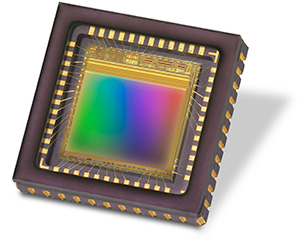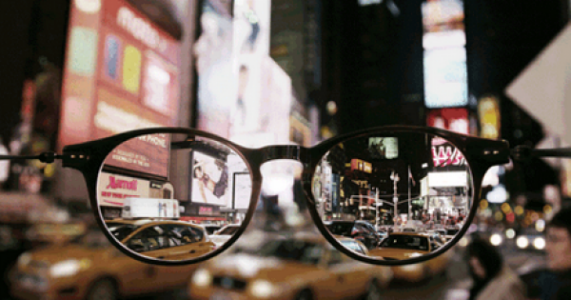Table of Contents
Is the Eye a Camera?

In some ways the eye is like a camera in how a lens is responsible for focusing light rays onto a medium that receives the light data. But there are important differences that have practical ramifications for how we use our eyes.
A modern digital camera receives light data onto a surface that translates the light frequencies into digital data, while an old style camera had a photosensitive film that the light affects. Either way, the entire recording area has the same sensitivity. In the eye, however, it’s different, because only a point in the very center is packed with the photoreceptor cells. The structure of the eye, then, dictates that we can only see best where we are looking.
What Central Fixation Means to Us
Scientific studies on the maximum capabilities of the eye’s central vision seem to treat everyone the same and don’t follow Dr. Bates’s example of finding people with unusually good vision to see how they perform on the tests. The thing is, most vision problems are psycho-physical disorders, and a person’s quality of vision, including refractive error and other aspects, correlates with the way they use their eyes. Most scientists and eye doctors don’t see this functional aspect necessary for good vision. To them, a person wearing glasses to “correct” the condition has solved the issue. They also do not see much difference between a person with ordinary good vision and a person with extraordinary vision, or they see extraordinary vision as nothing but luck and genetics.
Dr. Bates recognized long ago that the smaller the point you pay attention to, the better your vision. He knew that the physiology of the eye dictated this, and that people with extraordinary vision take advantage of this fact with the way they have become so good at using their eyes. Conversely, he also knew that there were consequences if a person deviated too far from this fact.

“The text-books say that at twenty feet an area having a diameter of half an inch can be seen with maximum vision, but anyone who tries at this distance to see every part of even the smallest letters of the Snellen test card – the diameter of which may be less than a quarter of an inch – equally well at one time will immediately become myopic. The fact is that the nearer the point of maximum vision approaches a mathematical point, which has no area, the better the sight.”
– Bates, Perfect Sight Without Glasses, Ch 11
This explains why we naturally move our eyes towards what we want to see. We see best where we are looking, and this becomes more true the smaller the point you look at.
But is that what you typically do yourself? How often do you actually move your eyes to point towards the details you’re paying attention to? How often do you even look for details?
Demonstrate Eccentric Fixation
If you have a refractive error such as myopia or hyperopia, try to demonstrate something right now. Look at a detailed object 20 feet away. How big is the area you see equally clearly?

If you have your glasses or contact lenses on, your area of maximum clarity may be a foot wide or even several feet wide. If you don’t have your glasses on, similarly, that same area may appear equally blurry.
But wait, the quote by Dr. Bates above says it should be smaller than a half inch. What gives?
Why did I say above that it’s easily verifiable that someone with normal vision sees this way, when you can demonstrate that you don’t see this way? What makes you different from someone with normal vision?
This is one effect of misuse of the eyes. When you learn to use your eyes in the way they were designed to be used, including correct application of central fixation, your area of maximum clarity will become smaller.
That doesn’t mean the rest of your vision will become worse. In fact, it will get better, and the center will get better still.
Peripheral Vision
I’m talking about central vision here. But at the same time, don’t try to block out your peripheral awareness. You don’t want to have tunnel vision, do you?
There’s a balance to be found in how you pay attention to your central and peripheral vision, between using your vision like a searchlight, with a narrow area of attention, and on the other hand relaxing your gaze by acknowledging your wider visual field. Central and peripheral vision blend into each other but are also different in the way they work. You can’t try to block out your peripheral vision and expect your vision to function and focus the way it’s supposed to.
Movement
The principles of good vision all tie together. You have to practice all of them or none will produce good results, or not the level of results you want, or not permanently. Every principle is part of the equation.
You can’t have central fixation without the right kind of movement.
The saccadic (tiny and quick) eye movements that some exercises help stimulate are fairly small movements. The eyes of a person with normal vision perform many quick, effortless saccades as a normal process of seeing. It’s so effortless that he doesn’t feel the movements. Microsaccades are even smaller movements that are done many times per second.
In contrast, a person with blurry vision tends to have severely reduced eye movements, and the movements he does do are larger, slower and full of tension.
Improving Your Vision
Better vision isn’t really about eye exercises. Better vision requires awareness as you perform exercises that demonstrate and help you practice the way your eyes work best. You’re exercising your brain more than anything, getting it to fully activate. With the use of the Bates method, the test card, and other procedures shared on this website, nearly anyone can improve his vision.
get help on our Facebook Group!

I founded iblindness.org in 2002 as I began reading books on the Bates Method and became interested in vision improvement. I believe that everyone who is motivated can identify the roots of their vision problems and apply behavioral changes to solve them.

It is interesting to know what part of the retina causes that small area to be clearest; its the fovea in the middle of the macula; the retina’s central field. In the center of the fovea; cones are packed together and close to the retina’s top layer. Blood vessels move to the side in order to let in more light. Its a very small area, it produces that point of maximum vision. I wonder how small the fovea/point of vision can go? ; Place 2 fine print periods side by side. Look at one. Let the eyes move the vision on it. That central field, area of very clear vision moves onto each part you look at. While looking at that small period; the other period is less clear. The period you are looking at ‘exactly’ the part of the period you are looking directly at is where the center of the fovea with its many cones are facing, focused. That part is most clear. Do not stare, do not ‘fix’ the eyes/vision immobile on the period; the eyes must continually move that fovea, exact central field to remain relaxed, maintain clarity. The eyes shift many times per second (includes tiny, microscopic shifts). The peripheral also moves. When the central has perfect clarity; the peripheral vision is at maximum clarity. A main cure for Strabismus; getting the best vision to return to the central. To remove the false macula in the retina (Naturally. NO surgery. It will resolve on its own) and use the true macula.
See best where you are looking as you let the eyes (vision) move. The vision becomes perfect and relaxed. The eyes move that fovea so quickly that all letters on a eyechart look perfect clear, equal clarity. If you stay on one letter, move on it; you will see that where you are looking – that letter is most clear.
Don’t spend all day testing your vision. See the chart clear, then move on to other objects. Movement, relaxation, an interested, entertained mind keep eyesight clear.
Try looking at the chart letters and do nothing. Just go into deeper and deer relaxation. Let the mind think something that you can feel change your body, mood to a subject that brings relaxation and happiness. Note the eyes move on their own on the letter and then jumps around to other letters., Vision is clear because you are not trying to see. You are not interfering with the eyes natural movement. Practicing shifting, central fixation is beneficial. But; the best vision is when we can get it to occur spontaneously; like taste, touch, smell…
Example; Margaret Corbett compares vision to touch; if you use effort, force; the vision is lowered. If you feel a piece of cotton material by squeezing it, pulling hard on it; you lose the feel of the material. If you gently touch, move on the fingers on it, maybe a little pressure at times to feel the cloth’s strength… ; you can feel it. If you look at something easy, relaxed, for fun; its clear.
Clark,
The false macula is interesting, but I can’t find much about it on the internet! Barely a definition. But at least there is stuff about eccentric fixation, besides just on vision improvement sites.
Can you tell me where to find stuff about eccentric fixation apart from vision improvement sites
David, good job. I wrote a post on this a while back too, as people who start reading about vision improvement often get confused about it, trying to hold what can seem like the contradictory concepts of movement (don’t stare!) and central fixation (look at a small point!) at the same time. Practicing and experience with noticing your own seeing habits teaches you the most, I’ve found. Thanks for one more key contribution.
It’s that aspect of balance of that underlies so much of this. Relax, but pay close attention.
I’ll have to add a link to your post. Is this the one?
http://www.iblindness.org/1411/how-do-i-practice-central-fixation/
‘Really any one can improve his vision,’ and ‘it is all about the brain’. These are 2 nice conclusions. I believe you summarized vision improvement.
Thanks Ismat, I’m glad you like it!